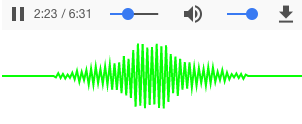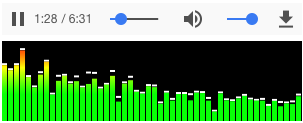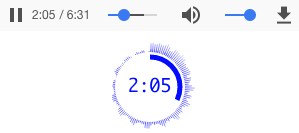File: //home/arjun/projects/buyercall/node_modules/vue-audio-visual/README.md
<p align="center">
<img src="https://github.com/staskobzar/vue-audio-visual/blob/master/static/logo.png?raw=true"/>
</p>
# vue-audio-visual
> [!CAUTION] This is version is compatible only with vue 2 and not fully
> supported. It will be soon deprecated.
[](https://github.com/staskobzar/vue-audio-visual/blob/master/LICENSE)
[](https://www.npmjs.com/package/vue-audio-visual)
> Vue HTML5 audio visualization components
- [Overview](#overview)
- [Install and setup](#install-and-setup)
- [API](#api)
- [Common props](#common-props)
- [Common events](#common-events)
- [AvLine props](#avline-props)
- [AvBars props](#avbars-props)
- [AvCircle props](#avcircle-props)
- [AvWaveform props](#avwaveform-props)
- [AvMedia props](#avmedia-props)
- [Issues](#issues)
- [License](#license)
## Overview
An audio spectrum visualizer plugin for [VueJS](https://vuejs.org/) framework.
It is built with HTML5
[Web Audio API](https://developer.mozilla.org/en-US/docs/Web/API/Web_Audio_API)
and compatible with all browsers that support HTML5 audio API. It provides
several Vue components that allows to draw light and nice visualization for
"audio" HTML elements. This plugin is compatible with Vue2 and Vue3 frameworks.
> There is a [**DEMO**](https://staskobzar.github.io/vue-audio-visual/)
> available.
Component **AvLine**. Vue template name **<av-line>**
```html
<av-line
:line-width="2"
line-color="lime"
audio-src="/static/music.mp3"
></av-line>
```
This will create following element:

Component **AvBars**. Vue template name **<av-bars>**
```html
<av-bars
caps-color="#FFF"
:bar-color="['#f00', '#ff0', '#0f0']"
canv-fill-color="#000"
:caps-height="2"
audio-src="/static/bach.mp3"
></av-bars>
```
This will create following element:

Component **AvCircle**. Vue template name **<av-circle>**
```html
<av-circle
:outline-width="0"
:progress-width="5"
:outline-meter-space="5"
:playtime="true"
playtime-font="18px Monaco"
audio-src="/static/bach.mp3"
></av-circle>
```
This will create following element:

Component **AvWaveform**. Vue template name **<av-waveform>**
```html
<av-waveform audio-src="/static/bar.mp3"></av-waveform>
```
This will create following waveform element:

Component will pre-load audio content and generate clickable waveform.
Component **AvMedia**. Vue template name **<av-media>**
```html
<av-media :media="mediaObject"></av-media>
```
This will create following media element:

## Install and setup
Install using npm
```
npm install --save vue-audio-visual
```
Enable plugin in main.js:
```javascript
import Vue from "vue";
import AudioVisual from "vue-audio-visual";
Vue.use(AudioVisual);
```
Example of usage in App.vue or any other Vue component:
```html
<av-bars audio-src="/static/bach.mp3"> </av-bars>
```
## API
There are three components that comes with plugin: av-line, av-bars, av-circle.
There are a lot of **props** available to configurate each component. The only
mandatory "prop" to pass to component: **audio-src**. Prop **audio-src** value
should contain URL to media file. Example:
```
audio-src="http://example.com/media/song.mp3"
```
Plugin will generate "audio" to control media playback and "canvas" element for
visualization.
Another way is to link to existing Vue element using "ref-link" property. When
"ref-link" property is set, then "audio-src" property is ignored.
```html
<audio ref="foo" src="music.mp3"></audio>
<av-bars ref-link="foo" />
<av-line ref-link="foo" />
```
However, it will reference **only** parent component elements.
There are props that are common for all components and special props for each
component.
### Common props
<table>
<thead>
<tr>
<th width="150">Name</th>
<th>Type</th>
<th>Default</th>
<th>Description</th>
</tr>
</thead>
<tbody>
<tr>
<td>audio-src</td>
<td><code>String</code></td>
<td><code>null</code></td>
<td>
Audio element src attribute. When provided creates audio element
wrapped in "div".
</td>
</tr>
<tr>
<td>audio-sink-device-id</td>
<td><code>String</code></td>
<td><code>null</code></td>
<td>
Id of the audio output device to be used as sink. When provided sets audio output device.
</td>
</tr>
<tr>
<td>ref-link</td>
<td><code>String</code></td>
<td><code>null</code></td>
<td>
Reference to parent audio element via Vue "ref" attribute. When set,
then local audio element is not created and the plugin will connect
audio analyser to parent audio element. Multiple plugin instances
can connect to the same audio element (see example above).
</td>
</tr>
<tr>
<td>audio-controls</td>
<td><code>Boolean</code></td>
<td><code>true</code></td>
<td>
Audio element controls attribute. When provided should
display audio element with controls.
</td>
</tr>
<tr>
<td>cors-anonym</td>
<td><code>Boolean</code></td>
<td><code>false</code></td>
<td>
Set CORS attribute for audio element. Set this attribute when using
audio source is pointing to different host/domain. When set, parameter
crossOrigin of audio element will be set to 'anonymous'.
</td>
</tr>
<tr>
<td>audio-class</td>
<td><code>String</code></td>
<td><code>null</code></td>
<td>Audio element css class name.</td>
</tr>
<tr>
<td>canv-class</td>
<td><code>String</code></td>
<td><code>null</code></td>
<td>Canvas element css class name.</td>
</tr>
<tr>
<td>canv-top</td>
<td><code>Boolean</code></td>
<td><code>false</code></td>
<td>By default plugin creates "audio" element wrapped in "div"
and puts "canvas" element below. When "canv-top" is "true" then
"canvas" element is set on top. Example:
<code> :canv-top="true"</code> or
<code> v-bind:canv-top="true"</code>
</td>
</tr>
<tr>
<td>canv-fill-color</td>
<td><code>String</code></td>
<td><code>null</code></td>
<td>Canvas fill background RGB color.
Default is null, which makes background transperent.
Examples:<br/>
<code>canv-fill-color="#00AAFF"</code><br/>
</td>
</tr>
</tbody>
</table>
### Common events
<table>
<thead>
<tr>
<th width="150">Name</th>
<th>Description</th>
</tr>
</thead>
<tbody>
<tr>
<td>playing</td>
<td>
Emitted when audio starts playing.
</td>
</tr>
<tr>
<td>paused</td>
<td>
Emitted when audio is paused.
</td>
</tr>
<tr>
<td>ended</td>
<td>
Emitted when audio is ended.
</td>
</tr>
</tbody>
</table>
### AvLine props
<table>
<thead>
<tr>
<th width="150">Name</th>
<th>Type</th>
<th>Default</th>
<th>Description</th>
</tr>
</thead>
<tbody>
<tr>
<td>canv-width</td>
<td><code>Number</code></td>
<td><code>300</code></td>
<td>Canvas element width. Default 300.
Example: <code>:canv-width="600"</code>
</td>
</tr>
<tr>
<td>canv-height</td>
<td><code>Number</code></td>
<td><code>80</code></td>
<td>Canvas element height. Default 80.
Example: <code>:canv-height="120"</code>
</td>
</tr>
<tr>
<td>line-width</td>
<td><code>Number</code></td>
<td><code>2</code></td>
<td>Graph line width in px. Integer or float number.
Example: <code>:line-width="0.5"</code>
</td>
</tr>
<tr>
<td>line-color</td>
<td><code>String</code>, <code>Array</code></td>
<td><code>#9F9</code></td>
<td>Graph line color. Can be string RGB color or Array of RGB color.
When Array is given, plugin creates linear gradient and set it as background.
Array value should be binded.
Examples:<br/>
<code>line-color="#00AAFF"</code><br/>
<code>:line-color="['#FFF', 'rgb(0,255,127)', '#00f']"</code>
</td>
</tr>
<tr>
<td>fft-size</td>
<td><code>Number</code></td>
<td><code>128</code></td>
<td>Represents the window size in samples that is used when performing
a Fast Fourier Transform (FFT) to get frequency domain data.<br/>
Must be power of 2 between 2<sup>5</sup> and 2<sup>15</sup>.
Example: <code>:fft-size="512"</code>
</td>
</tr>
</tbody>
</table>
### AvBars props
<table>
<thead>
<tr>
<th width="150">Name</th>
<th>Type</th>
<th>Default</th>
<th>Description</th>
</tr>
</thead>
<tbody>
<tr>
<td>canv-width</td>
<td><code>Number</code></td>
<td><code>300</code></td>
<td>Canvas element width. Default 300.
Example: <code>:canv-width="600"</code>
</td>
</tr>
<tr>
<td>canv-height</td>
<td><code>Number</code></td>
<td><code>80</code></td>
<td>Canvas element height. Default 80.
Example: <code>:canv-height="120"</code>
</td>
</tr>
<tr>
<td>bar-width</td>
<td><code>Number</code></td>
<td><code>5</code></td>
<td>Width of bars in pixels. Example: <code>:bar-width="12"</code>
</td>
</tr>
<tr>
<td>bar-space</td>
<td><code>Number</code></td>
<td><code>1</code></td>
<td>Space between bars. Example: <code>:bar-space="1.6"</code></td>
</tr>
<tr>
<td>bar-color</td>
<td><code>String</code>, <code>Array</code></td>
<td><code>#0A0AFF</code></td>
<td>Bar fill color. Can be string RGB color or canvas gradients array.<br/>
Examples:<br/>
<code>bar-color="#00AAFF"</code><br/>
<code>:bar-color="['#FFF', 'rgb(0,255,127)', 'green']"</code>
</td>
</tr>
<tr>
<td>caps-height</td>
<td><code>Number</code></td>
<td><code>0</code></td>
<td>Create caps on bars with given height in pixels.
When zero no caps created. Example: <code>:caps-height="2"</code>
</td>
</tr>
<tr>
<td>caps-drop-speed</td>
<td><code>Number</code></td>
<td><code>0.9</code></td>
<td>Caps drop down animation speed. The higher nubmer the faster caps are going down.
Example: <code>:caps-drop-speed="0.5"</code>
</td>
</tr>
<tr>
<td>caps-color</td>
<td><code>String</code></td>
<td><code>#A0A0FF</code></td>
<td>Caps rectangles RGB color.
Example: <code>caps-color="lime"</code>
</td>
</tr>
<tr>
<td>brick-height</td>
<td><code>Number</code></td>
<td><code>0</code></td>
<td>Draw bar as bricks when height is set and not zero.<br/>
Example: <code>:brick-height="6"</code><br/>
<img src="https://github.com/staskobzar/vue-audio-visual/blob/master/static/vav-bars-bricks.png?raw=true" />
</td>
</tr>
<tr>
<td>brick-space</td>
<td><code>Number</code></td>
<td><code>1</code></td>
<td>Space between bricks. Example: <code>:brick-space="2"</code>
</td>
</tr>
<tr>
<td>symmetric</td>
<td><code>Boolean</code></td>
<td><code>false</code></td>
<td>Draw bars symmetric to canvas vertical center.
Example: <code>:symmetric="true"</code><br/>
<img src="https://github.com/staskobzar/vue-audio-visual/blob/master/static/vav-bars-symm.png?raw=true" />
</td>
</tr>
<tr>
<td>fft-size</td>
<td><code>Number</code></td>
<td><code>1024</code></td>
<td>Represents the window size in samples that is used when performing
a Fast Fourier Transform (FFT) to get frequency domain data.<br/>
Must be power of 2 between 2<sup>5</sup> and 2<sup>15</sup>.
Example: <code>:fft-size="2048"</code>
</td>
</tr>
</tbody>
</table>
### AvCircle props
<table>
<thead>
<tr>
<th width="150">Name</th>
<th>Type</th>
<th>Default</th>
<th>Description</th>
</tr>
</thead>
<tbody>
<tr>
<td>canv-width</td>
<td><code>Number</code></td>
<td><code>100</code></td>
<td>Canvas element width.
Example: <code>:canv-width="600"</code>
</td>
</tr>
<tr>
<td>canv-height</td>
<td><code>Number</code></td>
<td><code>100</code></td>
<td>Canvas element height.
Example: <code>:canv-height="120"</code>
</td>
</tr>
<tr>
<td>radius</td>
<td><code>Number</code></td>
<td><code>0</code></td>
<td>Base circle radius. If zero, then will be calculated from canvas
width: (canv-width / 2) * 0.7
Example: <code>:radius="20"</code>
</td>
</tr>
<tr>
<td>line-width</td>
<td><code>Number</code></td>
<td><code>1</code></td>
<td>Frequency bit line width to draw.
Example: <code>:line-width="0.4"</code>
</td>
</tr>
<tr>
<td>line-space</td>
<td><code>Number</code></td>
<td><code>1</code></td>
<td>Space between lines to draw.
Example: <code>:line-space="2"</code>
</td>
</tr>
<tr>
<td>outline-color</td>
<td><code>String</code></td>
<td><code>#0000FF</code></td>
<td>Outline (contour) style RGB color.
Example: <code>outline-color="rgb(0,255,0)"</code>
</td>
</tr>
<tr>
<td>outline-width</td>
<td><code>Number</code></td>
<td><code>0.3</code></td>
<td>Outline (contour) line width. Float value.
Example: <code>:outline-width="1"</code>
</td>
</tr>
<tr>
<td>bar-width</td>
<td><code>Number</code></td>
<td><code>1</code></td>
<td>Frequency graph bar width.
Example: <code>:bar-width="1"</code>
</td>
</tr>
<tr>
<td>bar-length</td>
<td><code>Number</code></td>
<td><code>0</code></td>
<td>Frequency graph bar length/height.
Default is a difference between radius and canvas width.
Example: <code>:bar-length="27"</code>
</td>
</tr>
<tr>
<td>bar-color</td>
<td><code>String</code>, <code>Array</code></td>
<td><code>[#FFF,#00F]</code></td>
<td>Bar style RGB color or radient gradient when array.
Example: <code>:bar-color="#12AA55"</code>
</td>
</tr>
<tr>
<td>progress</td>
<td><code>Boolean</code></td>
<td><code>true</code></td>
<td>Draw playtime progress meter.
Example: <code>:progress="false"</code>
</td>
</tr>
<tr>
<td>progress-width</td>
<td><code>Number</code></td>
<td><code>1</code></td>
<td>Playtime progress meter width.
Example: <code>:progress-width="2.4"</code>
</td>
</tr>
<tr>
<td>progress-color</td>
<td><code>String</code></td>
<td><code>#0000FF</code></td>
<td>Playtime progress meter color.
Example: <code>:progress-color="green"</code>
</td>
</tr>
<tr>
<td>progress-clockwise</td>
<td><code>Boolean</code></td>
<td><code>false</code></td>
<td>Playtime progress meter arc draw direction.
Example: <code>:progress-clockwise="true"</code>
</td>
</tr>
<tr>
<td>outline-meter-space</td>
<td><code>Number</code></td>
<td><code>3</code></td>
<td>Space between outline and progress meter. The bigger the closer to the circle centre.
Example: <code>:outline-meter-space="1"</code>
</td>
</tr>
<tr>
<td>playtime</td>
<td><code>Boolean</code></td>
<td><code>false</code></td>
<td>Draw played time as text in the center of the circle.
Example: <code>:playtime="true"</code>
</td>
</tr>
<tr>
<td>playtime-font</td>
<td><code>String</code></td>
<td><code>14px Monaco</code></td>
<td>Played time print font.
Example: <code>playtime-font="18px monospace"</code>
</td>
</tr>
<tr>
<td>playtime-color</td>
<td><code>String</code></td>
<td><code>#00f</code></td>
<td>Played time font color.
Example: <code>playtime-color="green"</code>
</td>
</tr>
<tr>
<td>rotate-graph</td>
<td><code>Boolean</code></td>
<td><code>false</code></td>
<td>Rotate graph clockwise enable.
Example: <code>:rotate-graph="true"</code>
</td>
</tr>
<tr>
<td>rotate-speed</td>
<td><code>Number</code></td>
<td><code>0.001</code></td>
<td>Rotate graph speed.
Example: <code>:rotate-speed="0.2"</code>
</td>
</tr>
<tr>
<td>fft-size</td>
<td><code>Number</code></td>
<td><code>1024</code></td>
<td>Represents the window size in samples that is used when performing
a Fast Fourier Transform (FFT) to get frequency domain data.<br/>
Must be power of 2 between 2<sup>5</sup> and 2<sup>15</sup>.
Example: <code>:fft-size="2048"</code>
</td>
</tr>
</tbody>
</table>
### AvWaveform props
<table>
<thead>
<tr>
<th width="150">Name</th>
<th>Type</th>
<th>Default</th>
<th>Description</th>
</tr>
</thead>
<tbody>
<tr>
<td>canv-width</td>
<td><code>Number</code></td>
<td><code>100</code></td>
<td>Canvas element width.
Example: <code>:canv-width="500"</code>
</td>
</tr>
<tr>
<td>canv-height</td>
<td><code>Number</code></td>
<td><code>80</code></td>
<td>Canvas element height.
Example: <code>:canv-height="120"</code>
</td>
</tr>
<tr>
<td>played-line-width</td>
<td><code>Number</code></td>
<td><code>0.5</code></td>
<td>Waveform line width for played segment of audio.
Example: <code>:playtime-line-width="0.8"</code>
</td>
</tr>
<tr>
<td>played-line-color</td>
<td><code>String</code></td>
<td><code>navy</code></td>
<td>Waveform line color for played segment of audio.
Example: <code>:playtime-line-color="#ABC123"</code>
</td>
</tr>
<tr>
<td>noplayed-line-width</td>
<td><code>Number</code></td>
<td><code>0.5</code></td>
<td>Waveform line width for not yet played segment of audio
Example: <code>:noplayed-line-width="1"</code>
</td>
</tr>
<tr>
<td>noplayed-line-color</td>
<td><code>String</code></td>
<td><code>lime</code></td>
<td>Waveform line color for not yet played segment of audio.
Example: <code>:noplayed-line-color="grey"</code>
</td>
</tr>
<tr>
<td>playtime</td>
<td><code>Boolean</code></td>
<td><code>true</code></td>
<td>Display played time next to progress slider.
Example: <code>:playtime="false"</code>
</td>
</tr>
<tr>
<td>playtime-with-ms</td>
<td><code>Boolean</code></td>
<td><code>true</code></td>
<td>Display milliseconds in played when true. For example: 02:55.054.
Example: <code>:playtime-with-ms="false"</code>
</td>
</tr>
<tr>
<td>playtime-font-size</td>
<td><code>Number</code></td>
<td><code>12</code></td>
<td>Played time print font size in pixels.
Example: <code>:playtime-font-size="14"</code>
</td>
</tr>
<tr>
<td>playtime-font-family</td>
<td><code>String</code></td>
<td><code>monospace</code></td>
<td>Played time print font family.
Example: <code>:playtime-font-family="monaco"</code>
</td>
</tr>
<tr>
<td>playtime-font-color</td>
<td><code>String</code></td>
<td><code>grey</code></td>
<td>Played time print font RGB color string.
Example: <code>:playtime-font-color="#00f"</code>
</td>
</tr>
<tr>
<td>playtime-text-bottom</td>
<td><code>Boolean</code></td>
<td><code>false</code></td>
<td>Position playtime text bottom. Default on top.
Example: <code>playtime-text-bottom</code>
</td>
</tr>
<tr>
<td>playtime-slider</td>
<td><code>Boolean</code></td>
<td><code>true</code></td>
<td>Draw played time slider on the waveform.
Example: <code>:playtime-slider="false"</code>
</td>
</tr>
<tr>
<td>playtime-slider-color</td>
<td><code>String</code></td>
<td><code>red</code></td>
<td>Played slider color.
Example: <code>:playtime-slider-color="#fafafa"</code>
</td>
</tr>
<tr>
<td>playtime-slider-width</td>
<td><code>Number</code></td>
<td><code>1</code></td>
<td>Played slider width.
Example: <code>:playtime-slider-width="2.5"</code>
</td>
</tr>
<tr>
<td>playtime-clickable</td>
<td><code>Boolean</code></td>
<td><code>true</code></td>
<td>Allow click on waveform to change playtime.
Example: <code>:playtime-clickable="false"</code>
</td>
</tr>
<tr>
<td>requester</td>
<td><code>Object</code></td>
<td><code>new axios instance</code></td>
<td>Allow set a custom requester (axios/fetch) to be used.
Example: <code>:requester="myCustomRequesterInstance"</code>
</td>
</tr>
</tbody>
</table>
### AvMedia props
Please note that common pros are not usable for that element.
Vue component example with media from user device.
```vue
<template>
<audio ref="player" controls />
<av-media :media="media" />
</template>
<script>
export default {
name: "HelloWorld",
data() {
return {
media: null,
};
},
mounted() {
const constraints = { audio: true, video: false };
navigator.mediaDevices.getUserMedia(constraints).then((media) => {
this.media = media;
this.$refs.player.srcObject = media;
});
},
};
</script>
```
<table>
<thead>
<tr>
<th width="150">Name</th>
<th>Type</th>
<th>Default</th>
<th>Description</th>
</tr>
</thead>
<tbody>
<tr>
<td>media</td>
<td><code>MediaStream</code></td>
<td><code>none</code></td>
<td>Required property. See example above.</td>
</tr>
<tr>
<td>canv-width</td>
<td><code>Number</code></td>
<td><code>300</code></td>
<td>Canvas element width. Default 300.
Example: <code>:canv-width="600"</code>
</td>
</tr>
<tr>
<td>canv-height</td>
<td><code>Number</code></td>
<td><code>80</code></td>
<td>Canvas element height. Default 80.
Example: <code>:canv-height="120"</code>
</td>
</tr>
<tr>
<td>canv-class</td>
<td><code>String</code></td>
<td><code>null</code></td>
<td>Canvas element css class name.</td>
</tr>
<tr>
<td>type</td>
<td><code>String</code></td>
<td><code>wform</code></td>
<td>Type of media visualization. Currently supplies two types: 'wform', 'circle' and 'frequ'.
If not set or not recognized then 'wform' is set. <br/>
Example: <code>type="frequ"</code>
</td>
</tr>
<tr>
<td>fft-size</td>
<td><code>Number</code></td>
<td><code>1024/8192</code></td>
<td>Represents the window size in samples that is used when performing
a Fast Fourier Transform (FFT) to get frequency domain data.
Default 8192 for the type 'wform' or 1024 for 'frequ'
<br/>
Example: <code>:fft-size="512"</code>
</td>
</tr>
<tr>
<td>frequ-lnum</td>
<td><code>Number</code></td>
<td><code>60</code></td>
<td>Number of vertical lines for 'frequ' type.
Example: <code>:frequ-lnum="30"</code>
</td>
</tr>
<tr>
<td>frequ-line-cap</td>
<td><code>Boolean</code></td>
<td><code>false</code></td>
<td>Draw lines of 'frequ' type with rounded caps.
Example: <code>:frequ-line-cap="true"</code>
</td>
</tr>
<tr>
<td>frequ-direction</td>
<td><code>String</code></td>
<td><code>lr</code></td>
<td>Direction to draw the frequency. Available values: 'lr' or 'mo' (left to right or middle out).
If not set or not recognized then 'lr' is set. <br/>
Example: <code>frequ-direction="mo"</code>
</td>
</tr>
<tr>
<td>line-color</td>
<td><code>String</code></td>
<td><code>#9F9</code></td>
<td>Graph line RGB color.
Examples:<br/>
<code>line-color="#00AAFF"</code>
</td>
</tr>
<tr>
<td>line-width</td>
<td><code>Number</code></td>
<td><code>0.5 / 3</code></td>
<td>Graph line width in px. Integer or float number.
If not set then 0.5 for 'wform' type and 3 for 'frequ'
Example: <code>:line-width="0.8"</code>
</td>
</tr>
<tr>
<td>radius</td>
<td><code>Number</code></td>
<td><code>0</code></td>
<td>Base 'circle' radius.
Example: <code>:radius="4"</code>
</td>
</tr>
<tr>
<td>connect-destination</td>
<td><code>Boolean</code></td>
<td><code>false</code></td>
<td>Analyser to connect to audio context's destination.
Avoid echo during playback.
Example: <code>:connect-destination="true"</code>
</td>
</tr>
</tbody>
</table>
## License
[MIT](http://opensource.org/licenses/MIT) Copyright (c) 2018-present, Stas
Kobzar